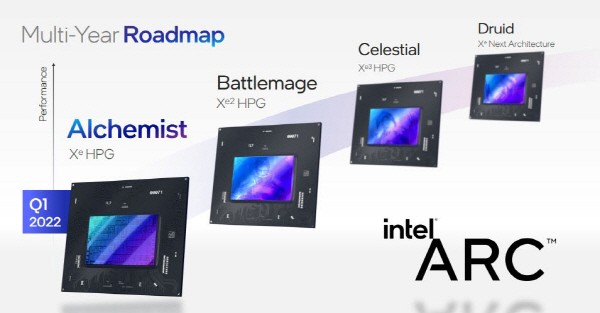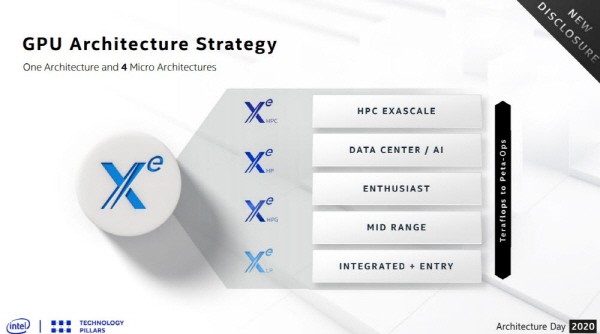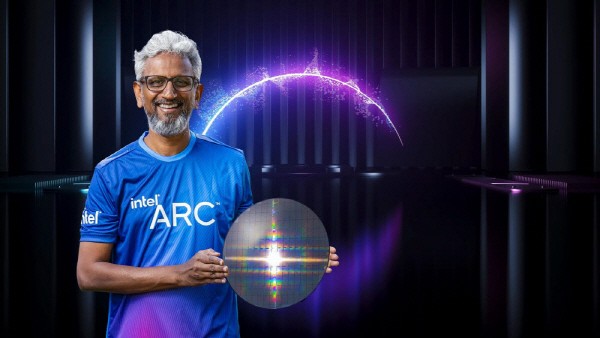Unveils 'Intel ARC’, a high-performance PCbrand
Releasing in the first quarter of next year... Targeting the gaming market
Completion of full lineup including servers and supercomputers
Chasing the
Intel will release an external graphics processing unit (GPU) for high-performance PCs next year. Intel, which has unveiled external GPUs for low-power servers, machine learning and development, supercomputers, and data centers, has completed their product portfolio by introducing high-performance PC GPUs. Intel, which is leading the built-in GPU market, has expanded their base to external GPUs, heralding a change in the global GPU market.

Intel recently unveiled 'Intel ARC’, a brand of external GPU products for high-performance PCs. The first product name is Alchemist. It is expected to be released in the first quarter of next year. After Alchemist, Intel also presented a roadmap for high-performance PC GPUs such as Battle Mage, Celestial, and Druid.They have prepared a long-term business strategy to preoccupy the external GPU market.
Intel ARC is designed to provide outstanding scalability and computing efficiency based on micro-architecture. It is produced using 6-nano advanced micro processing. Alchemist, the first Intel’sARC product, has significantly improved performance through architecture, logic design, process technology and software optimization. Compared to the GPU architecture for servers announced by Intel in November last year, the clock speed and performance per watt are improved by 1.5 times. Intel plans to focus on the rapidly growing gaming PC market with ARC.
As Intel launched ARC brand, they completed △low power GPU (Xe-LP) △machine learning and development GPU (Xe-HP) △supercomputing and data center GPU (Xe-HPC) △high performance PC GPU (Xe-HPG) and other external GPU product portfolios.

Intel's strategy is interpreted as an intention to take the lead in the external GPU market. According to market research company Statista, in the second quarter, Intel's share of the global PC GPU market was 68.3%, which is very solid first place. However, the competitiveness of the integrated GPU market did not shine in the external GPU market. The market share of the external GPU market is 80% by Nvidia and 20% by AMD, which is a 'one strong, one weak' system.
Intel began to launch full-scale products from 2020 after estimating the growth potential of the external GPU market. The Intel Iris Xe Max, which was unveiled last November, is a representative example. It is Intel's first Xe architecture-based external GPU and is intended for notebook use. In addition, Intel showed its confidence in targeting the external GPU market by introducing external GPUs for servers, development, and supercomputers one after another.
Intel accumulated competitiveness throughout the supply chain through external GPUs last year. Intel Vice President Roger Chandler said, “Through the first external GPU (Xe Max), we gained know-how on how to cooperate with the ecosystem, such as external production.Through this experience, we found the opportunity to find a new market.”
With the release of Intel's high-performance external GPU for PC next year, the GPU market is expected to change. In particular, Intel plans to speed up its market penetration by optimizing the overall performance of the platform by utilizing both the central processing unit (CPU) and GPU. By maximizing synergies between products, it aims for a soft landing in the market. "We expect to gain significant market share in the external GPU market within the next few years," said Chandler.

Intel Senior Vice President Raja Koduri said, "Intel already has the capacity and experience to produce external GPUs on its own.” And he continued, “In the future, we will closely examine the product roadmapand review the in-house production of external GPU products.”
By Staff Reporter Dong-jun Kwon (djkwon@etnews.com)